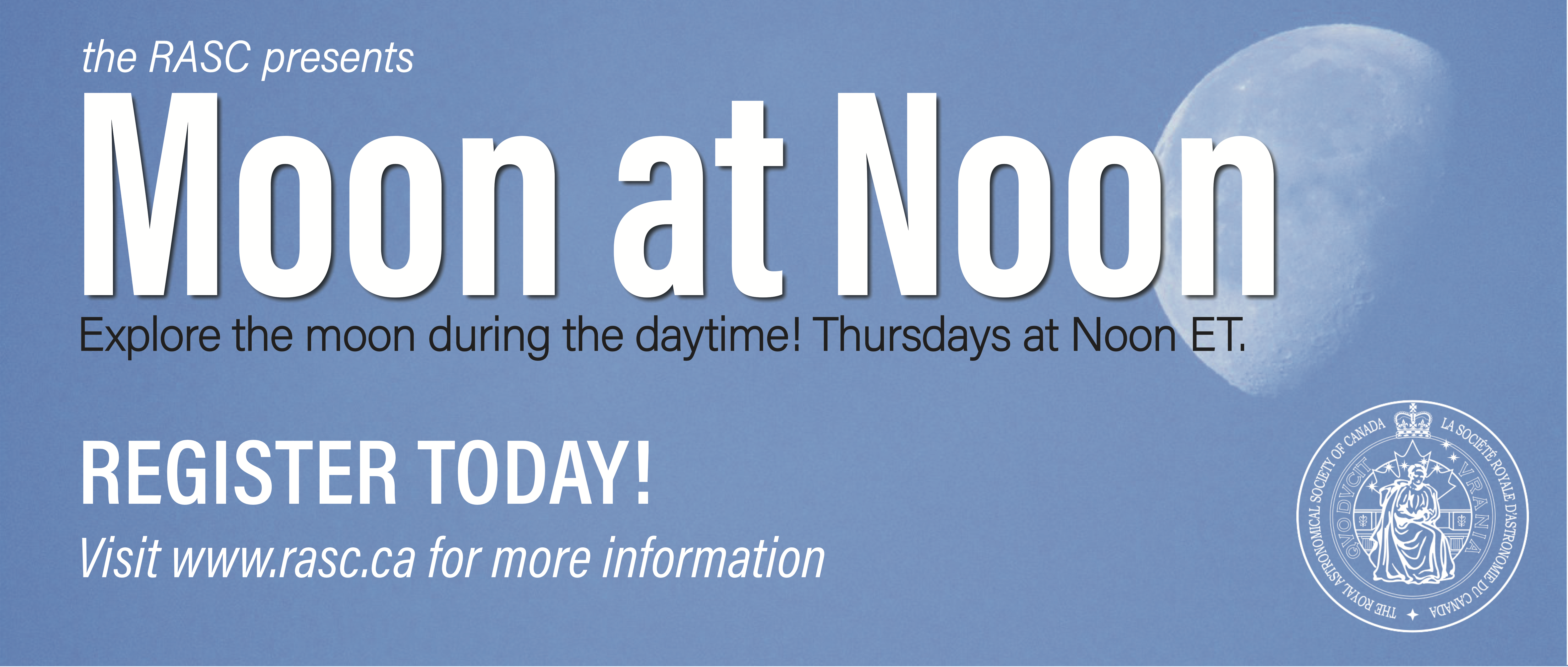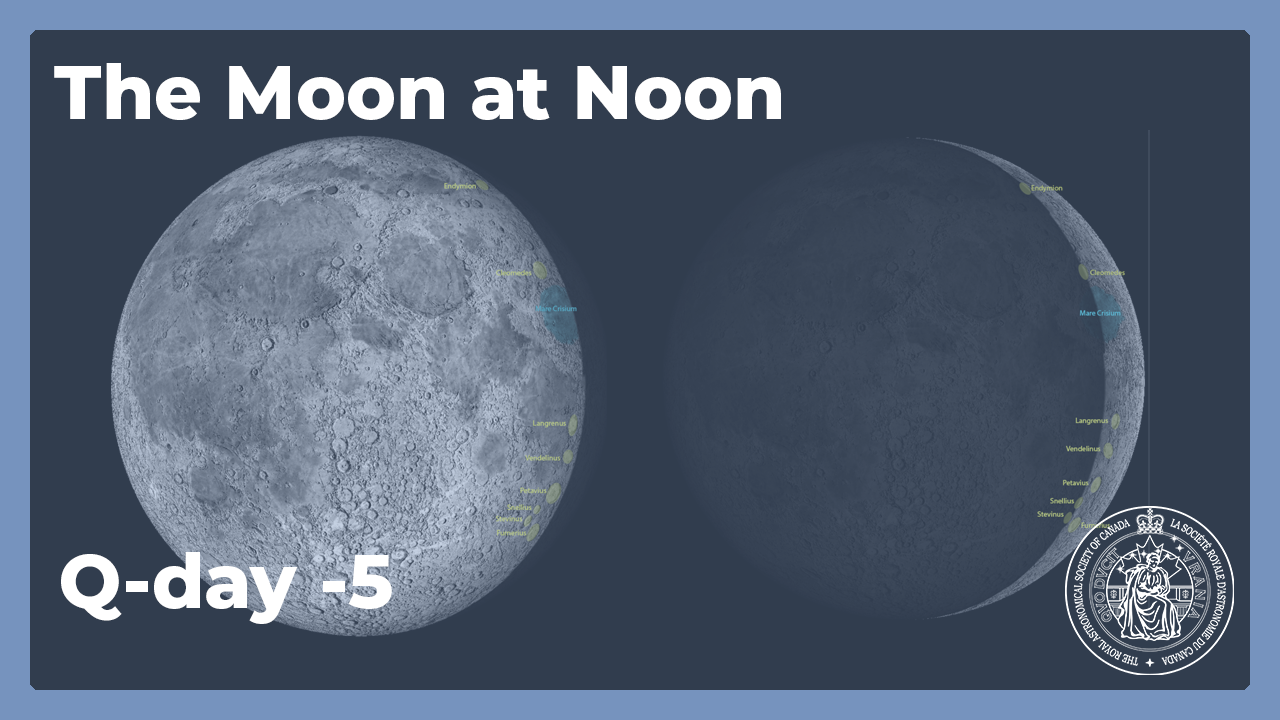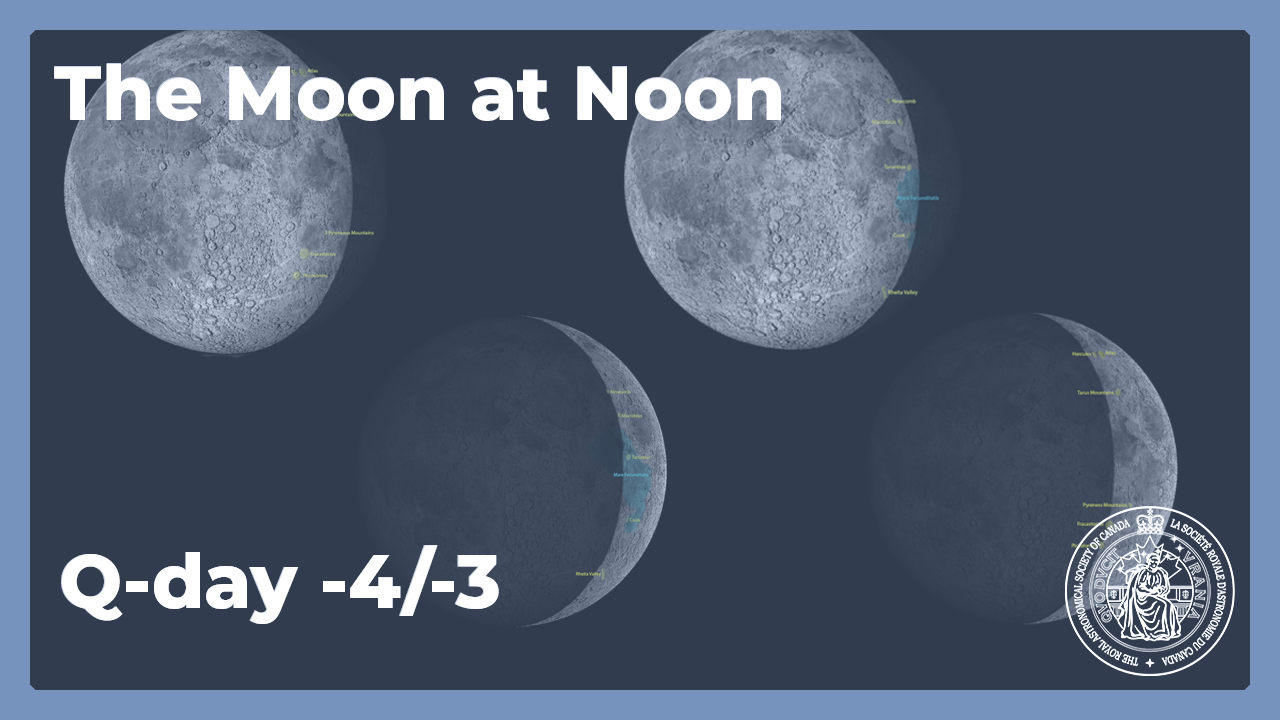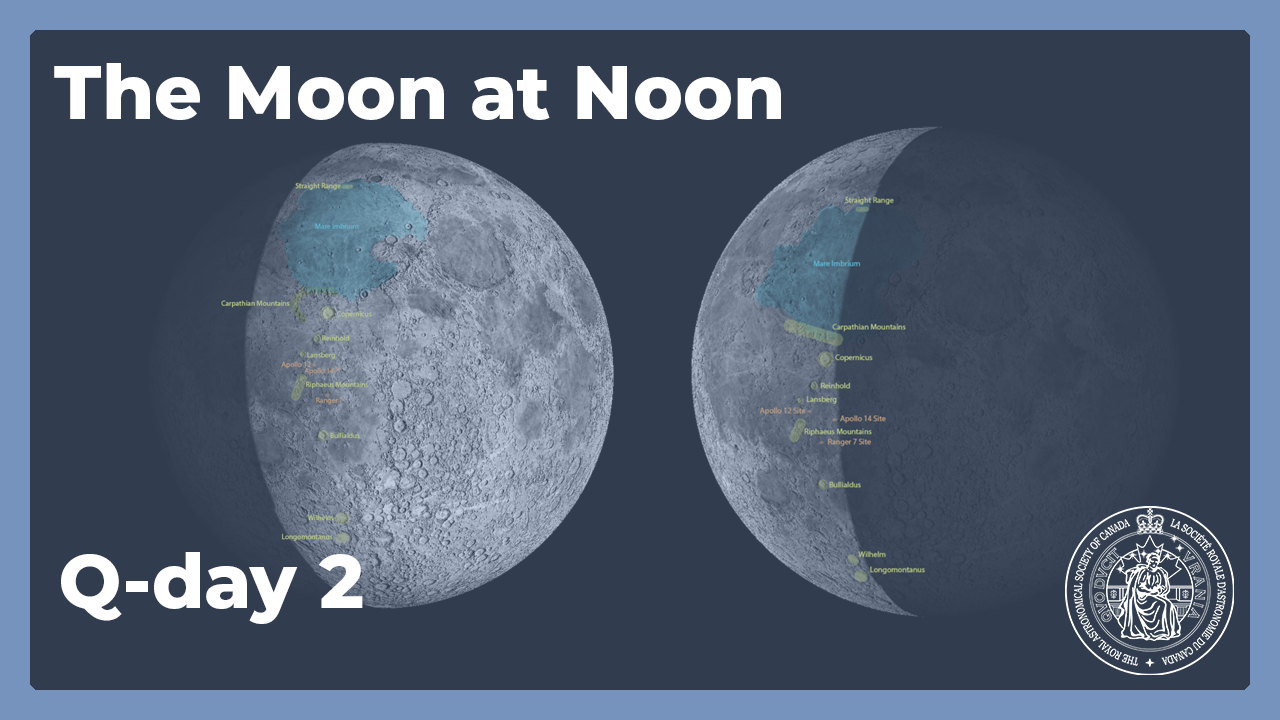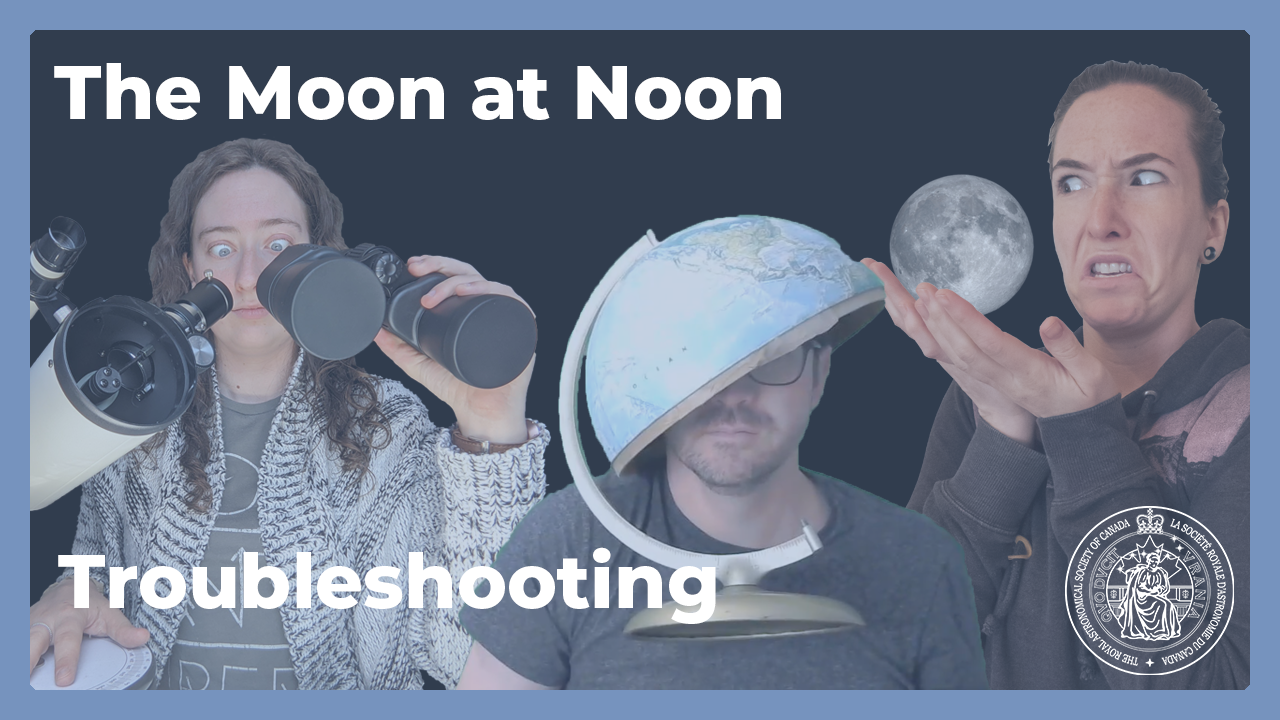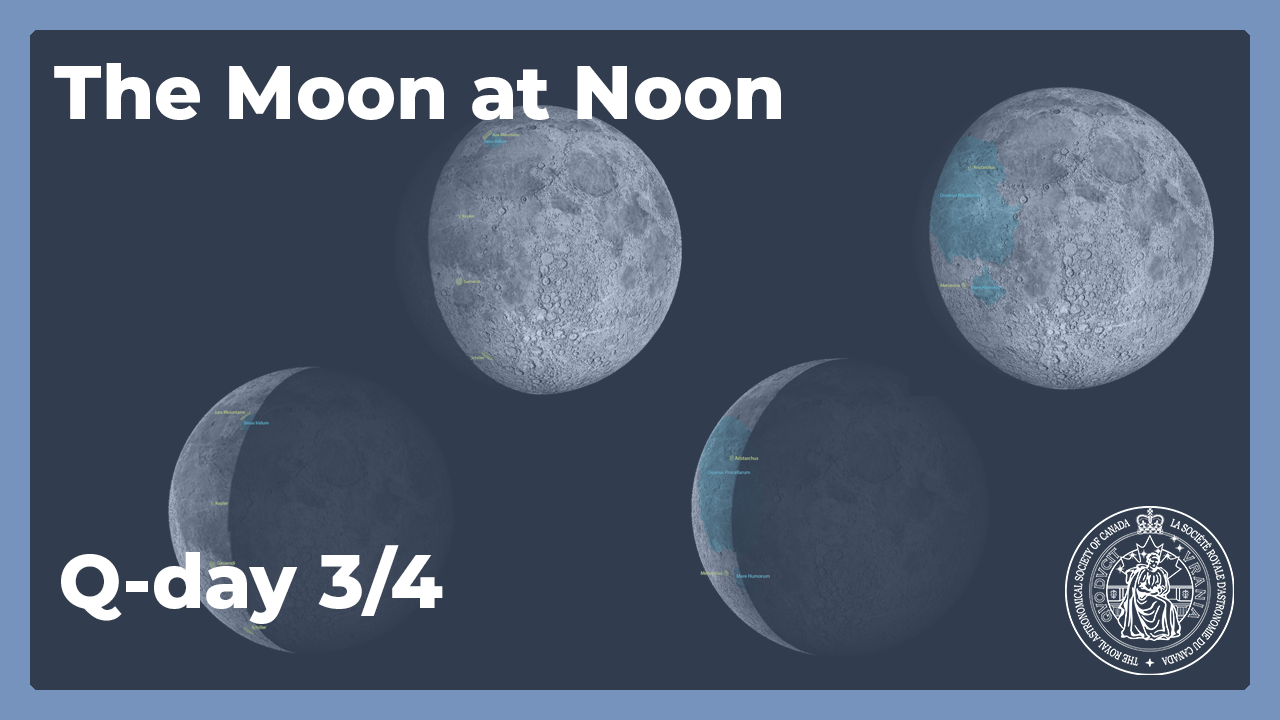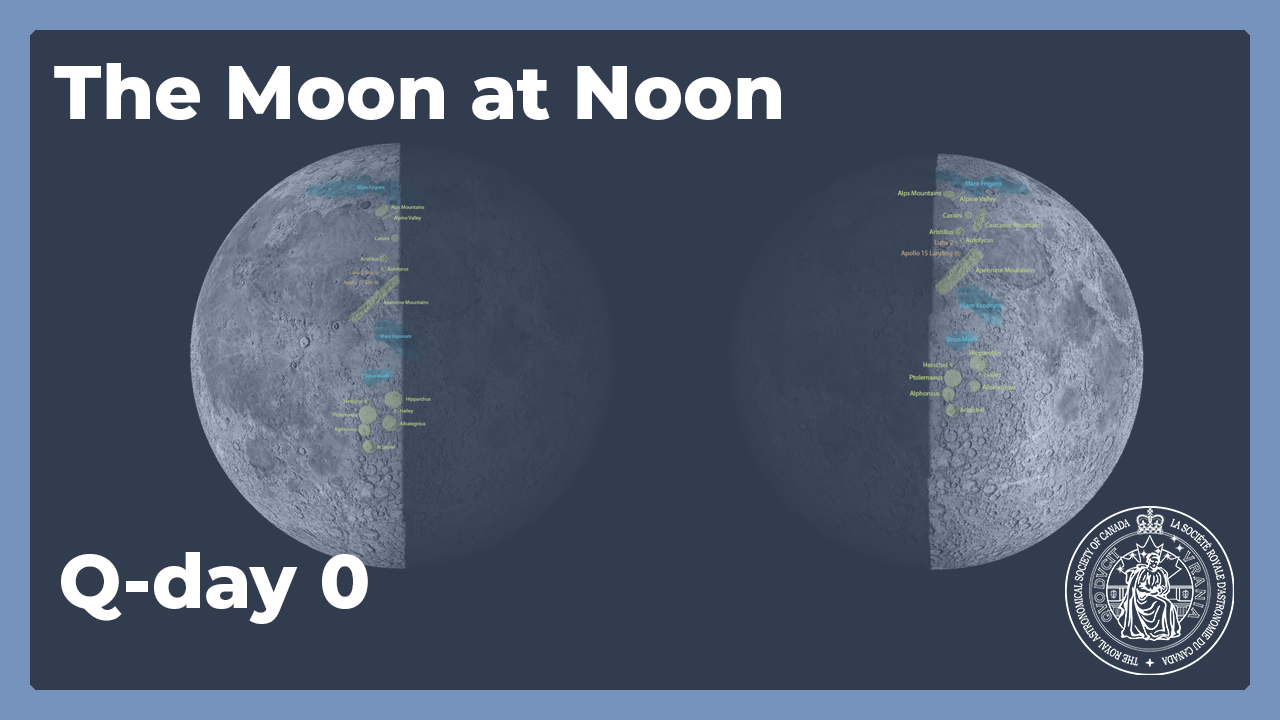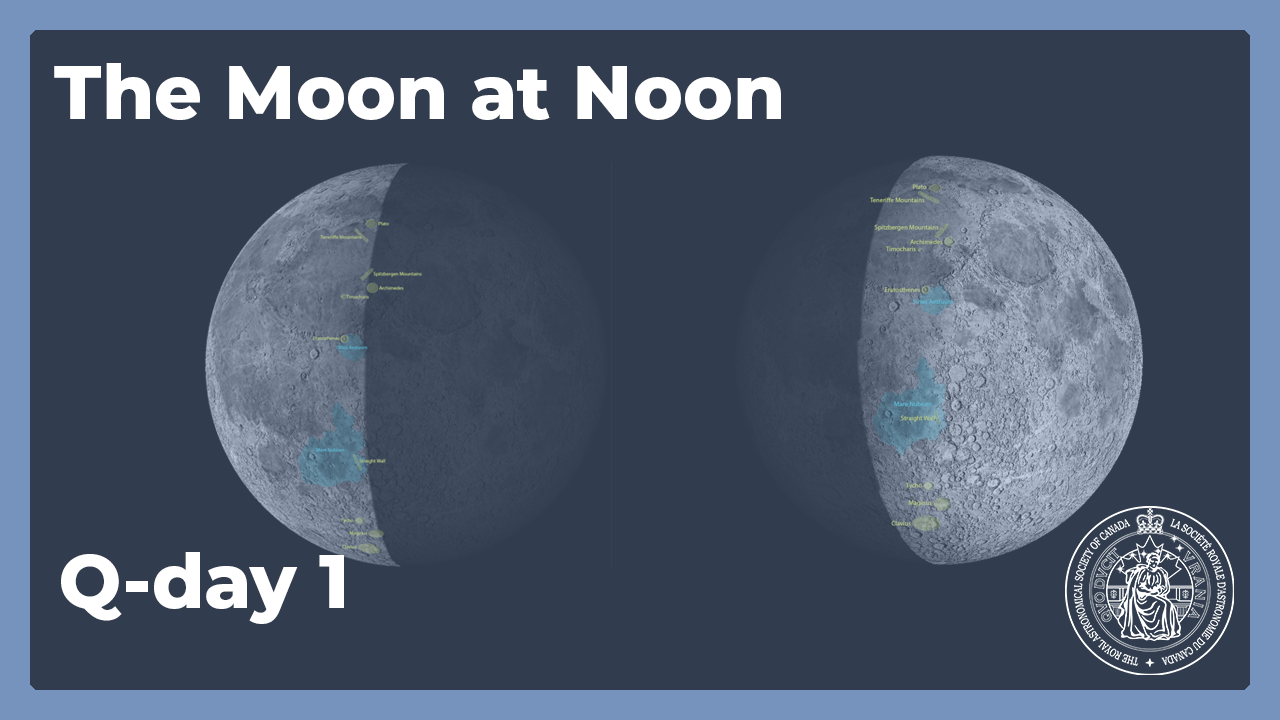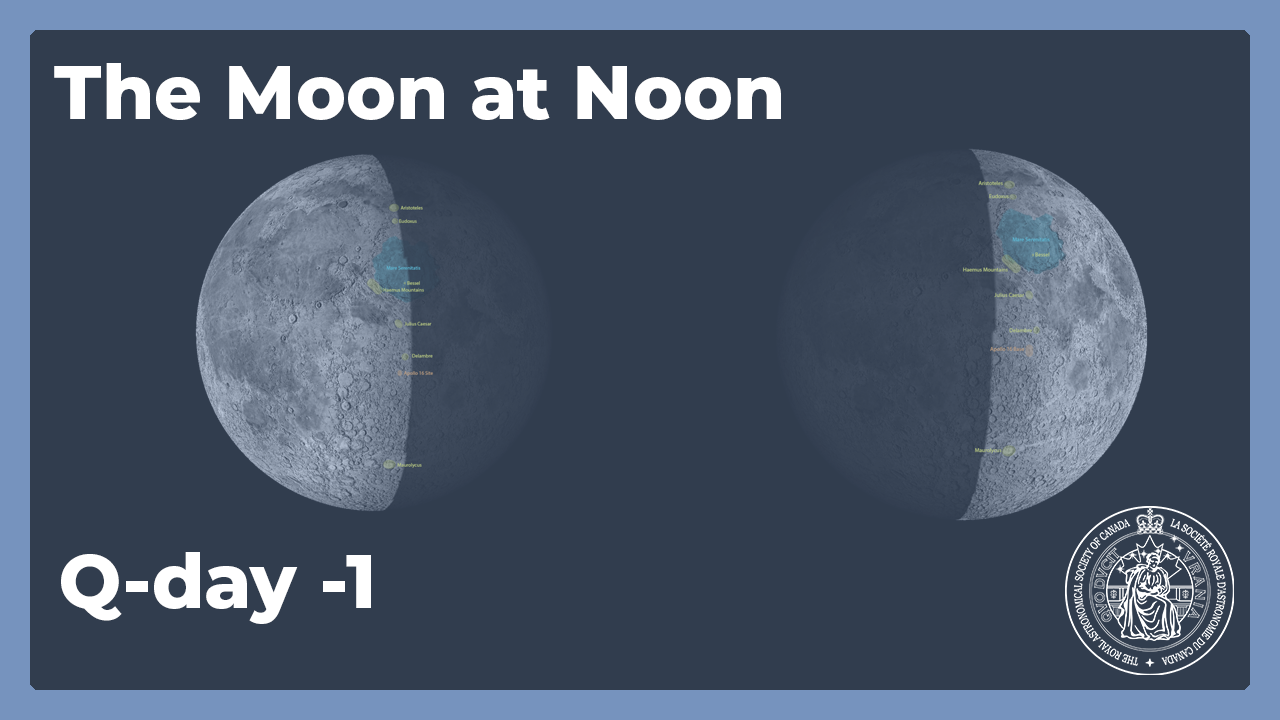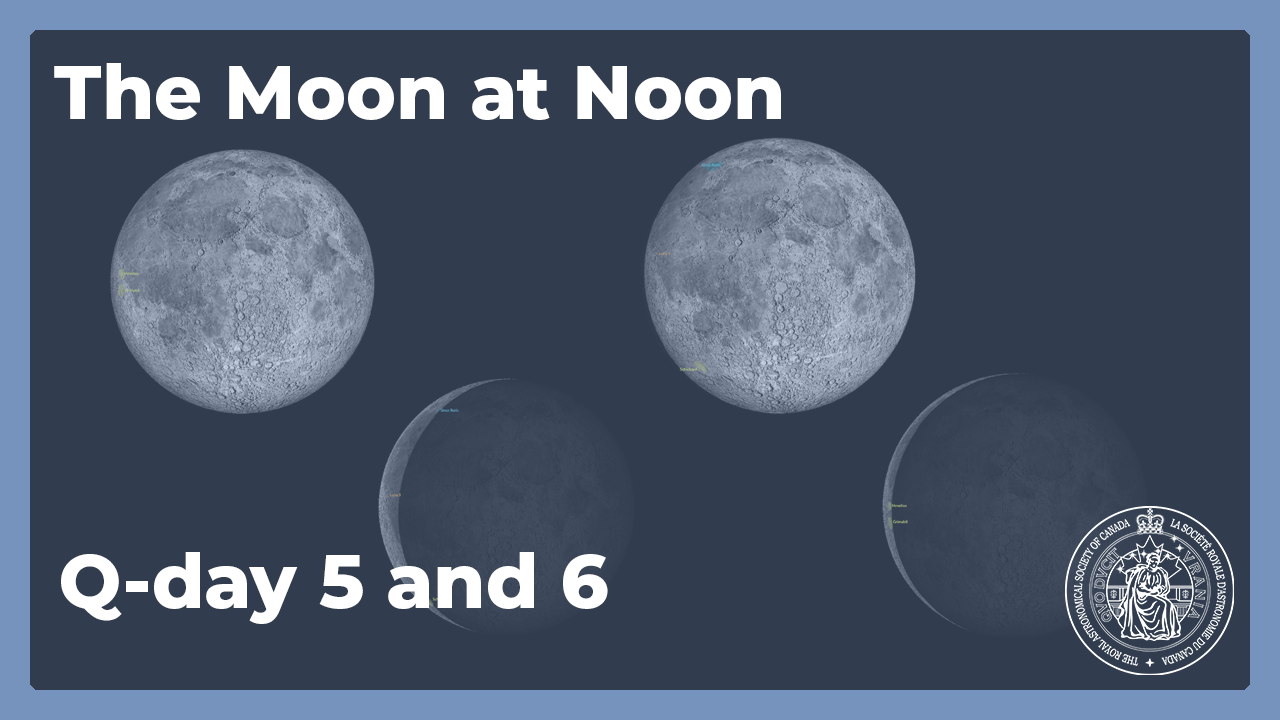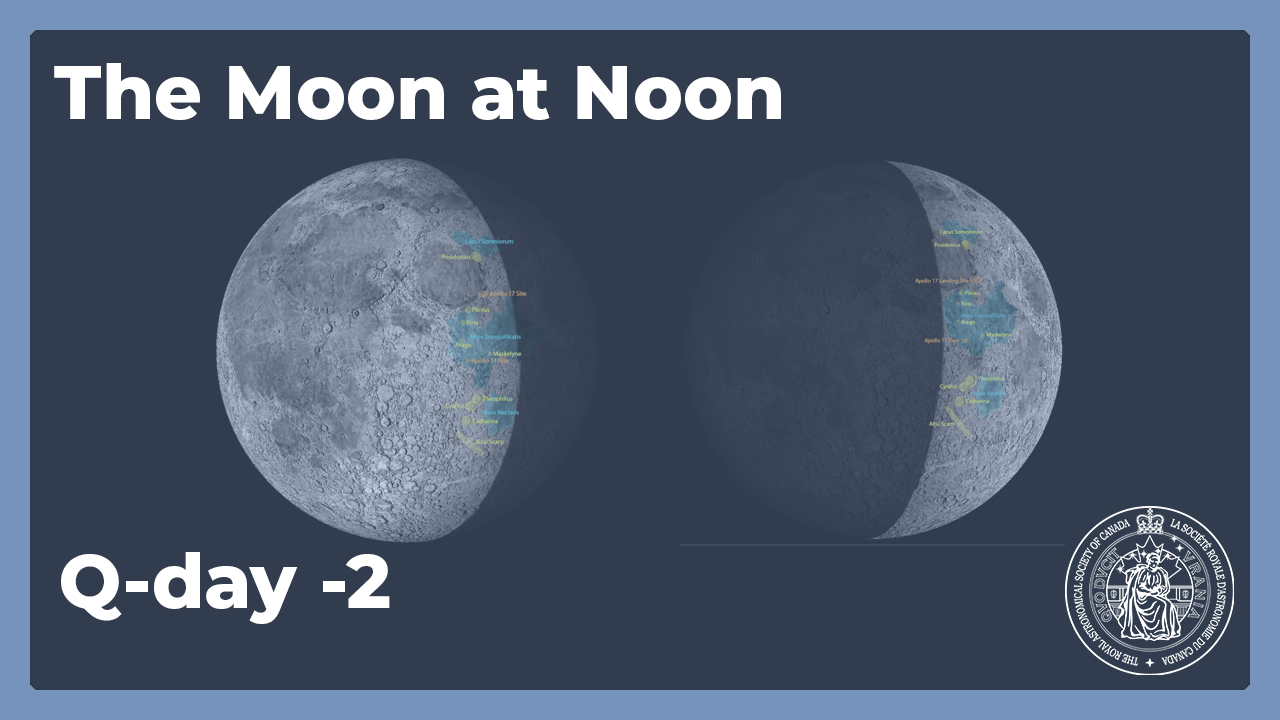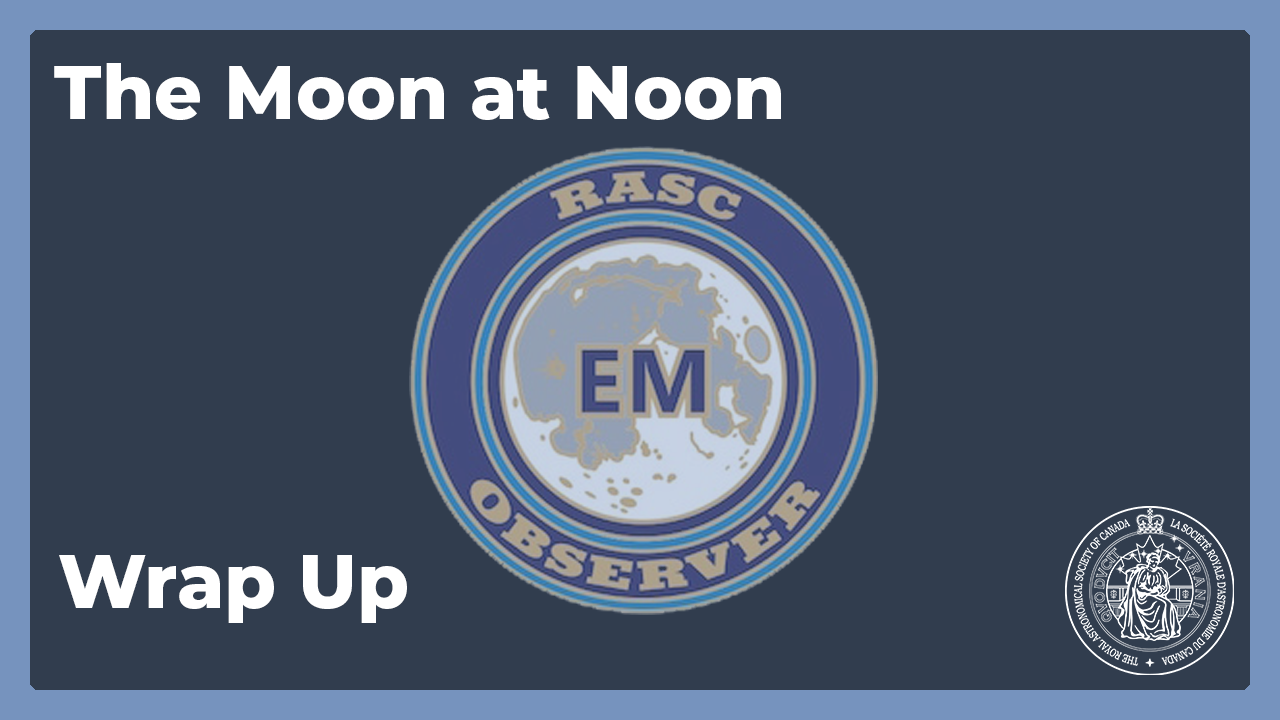Thank you for joining us for the Moon at Noon!
We have finished this program. The series can be rewatched anytime in broadcast order here.
This program leads you through how to observe the Moon using RASC's Q-day system! It follows the RASC Observing Program Explore the Moon. You can rewatch any episode anytime since the Moon goes through its full cycle in only 29.5 days!
Anyone can join as we dive into craters and climb mountain ranges on our nearest neighbour. Stay tuned for more details, and keep an eye on this page for all the information you need about this program!
By the end of the program, you'll know how to find all the objects on the Moon listed in the Explore the Moon Program, both for binoculars and telescopes. If you are a member of the RASC and you note down all your observations, you'll be able to apply for your certificate. If you complete the telescope version, you'll get a pin too!
What do you need?
There are two options for completing this program: the binocular version, or the telescope version. You'll need whichever of those tools you'd like to use! For the binocular program, we recommend a pair 10x magnification or greater. A tripod or other stabilization may help. For the telescope program, any small scope will do. It helps to have multiple eyepieces at different focal lengths to get different views of the Moon. You may also want a lunar filter for your eyepiece, or a pair of sunglasses.
Don't forget a notebook or logbook to keep track of your observations, and some pencils if you would like to sketch the Moon!
When?
Rewatch this series anytime on YouTube! Links to individual videos are below, or you can watch the playlist in broadcast order here.
How does it work?
This program was developed using Q-days, or the number of days before or after the Quarter Moon, and we will be following along with these. Targets are grouped by Q-days, so you can catch as many targets as possible on any single night!
Program Schedule
|
Date
|
Topic
|
|---|---|
|
April 1, 2021
|
Introduction
Welcome to the program! This session we'll be going over some basic information that you may find helpful throughout the course. We'll talk about Q-days, how to keep track of the lunar cycle, when to observe, and how the course will be structured. We'll also go over some lunar sketching tips so you can spice up your logbook!
|
|
April 8, 2021
|
Q-day –5
Where do you find mountain ranges, craters and lava plains on the Moon? We'll be talking about common features, how we find them, and how we use cardinal directions on the Moon. Bring something round (a golf ball or styrofoam crafting ball are pefect) and you can join in while we simulate the Moon's orbit!
|
|
April 15, 2021
|
Q-day –4 and Q-day –3
We have lots of cool-looking craters on our target lists today, so we'll be going over how to identify crater features. Things might get a little messy! If you want to join in, bring the materials you would normally use for chocolate chip cookies.
|
|
April 22, 2021
|
Q-day 2
We have our first day of finding lunar landing locations! Moon at Noon cohost John loves the Apollo missions, so you bet we'll be talking about Apollo 12 and 14. We'll show you where Ranger 7, a critical US mission, "landed" (technically it hit the Moon at 2.6 kilometers per second). We might even discuss the potential of creating Moon bases, and what our lives would look like on the Moon.
|
|
April 29, 2021
|
Troubleshooting
We'll be taking a pause on targets today to talk about any observing problems you may be tackling. Bring your questions and troubles, and we'll dive into solutions.
No observing this week!
|
|
May 6, 2021
|
Q-day 3 and Q-day 4
For the first time in this series, we'll be looking for the Moon in the morning (or really late at night, if you're a night owl). We'll spend some extra time on how to observe the Moon during the day. We're also going to talk about Rayleigh Scattering, the phenomenon that makes the sky appear blue!
|
|
May 13, 2021
|
Q-day 0
We have a whopping 19 targets to cover this session, so we will spend lots of time focusing on how to find them! These include some optional lunar mission targets, like Luna 2 and Apollo 15, the Apollo mission with the first use of the LRV (so astronauts could do donuts on the Moon, instead of in abandoned parking lots).
|
|
May 20, 2021
|
Q-day 1
John's going to show us how to take photos of the Moon through our telescopes or binoculars today! We'll also talk about lunar libration and how to observe some unique objects on the edge of the Moon by looking at the right time. Starting today we will also be adding sketching sections to our meetings, between 12:30 and 12:45pm. Bring your pencils and paper if you'd like to join in!
|
|
May 27, 2021
|
Q-day –1
Today's targets will be more morning observations, and include the Apollo 16 landing site! Apollo 16 was the second Apollo mission to land in the highlands (all the others landed in the seas), and discovered some really cool stuff about mountain formation on the Moon. In honour of this mission, we'll talk about lunar geology.
|
|
June 3, 2021
|
Q-day 5 and Q-day 6
Next week there will be a partial solar eclipse! In some places it'll even be an annular eclipse. We'll be spending this session talking about eclipses. How come they don't happen every new Moon? How come only some places can see them? Why are Earth's solar eclipses so special? And finally, how can we observe the eclipse next week?
|
|
June 10, 2021
|
Q-day –2
It's Apollo day! Finally, we get the chance to find both the first and last Apollo landing sites. Bring your questions about the Moon landings! We encourage you to share any annular eclipse photos you may have gotten from this morning as well.
|
|
June 17, 2021
|
Review and Apply
Did you manage to find all the targets? We'll go over everything you need to know to apply for your observing certificate! Who doesn't love a certificate?
Do you want to share the program with your friends, or go over targets at another time? Easy peasy. We'll talk about how to redo the program using the recordings of all our sessions.
|
Program Resources
|
Topic
|
Links
|
|---|---|
|
Program Tools
|
Explore the Moon - Binocular Guide (available in French)
Explore the Moon - Telescope Guide (available in French)
Photographic Album of EtM Features
|
|
Calendar
|
This calendar has Q-days listed for each day of this program. It also tells you which nights or mornings are for observing!
|
|
Helpful Books
|
Explore the Moon with Binoculars: Workbook
Explore the Moon with a Small Telescope: Workbook
50 Things to See on the Moon, by John A. Read
50 choses à voir sur la Lune, par John A. Read
50 Things to See with a Telescope: Activity Workbook, by John A. Read
|
|
Helpful Articles and Videos
|
How to Draw the Moon - using pastels!
Become a Better Observer: Sketch!
|
|
Apps and Websites
|
Virtual Moon Atlas - Windows only, great for visualising what the Moon is doing
NASA Dial-A-Moon - shows you exactly what the Moon will look like at any time or date in 2021
3D Moon - grab those red-and-blue glasses and check out this 3D photo of the Moon!
LROC Quickmap - extremely detailed map of the Moon from the Lunar Reconnaisance Orbiter data
Astrospheric - weather predictions and Moon phase, good for planning observing
Derekscope - photos of the Moon at each phase. Careful, though; the views are flipped around!
|
|
Demos
|
Crater sketching - Karim Jaffer, RASC Montreal
Crater flour and cocoa powder demonstration - Paul Heath, RASC Halifax
|
Q-Day Moon Maps

